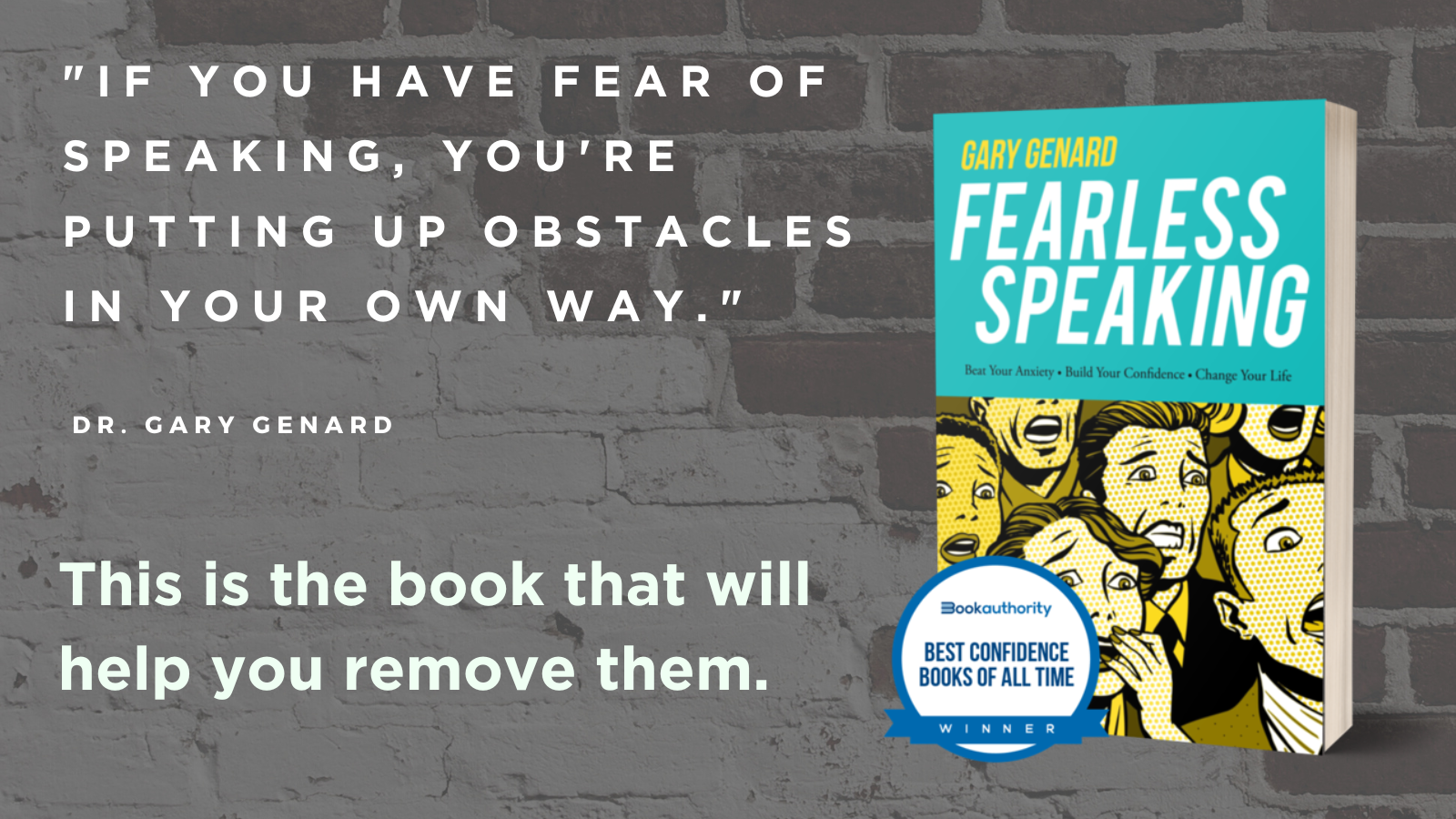You have everything you need to be an effective speaker. So, why are you anxious? Here's how your brain tricks you into feeling stage fright.
When we last discussed speech anxiety, I shared how the emotional part of your brain can embed negative emotions regarding public speaking. We call that structure the limbic system. It is, in fact, the emotional center of the brain that can at times overrule the executive brain or prefrontal cortex.
And you thought that learning to think like an executive would reason away all obstacles.
Speech anxiety? Ready to beat it and CHANGE YOUR LIFE? Conquer stage fright in as little as 12 days! Get a signed copy of my book, Fearless Speaking. Or, find it on Amazon.
With this knowledge in tow, we're ready to look more closely at the section of the brain which actually sets off the alarm bells. This is the area that's involved when you suddenly go blank at the opening of a speech, or when you panic and start looking for the exits. It's called the amygdala, and it is squarely at the intersection of the public speaking situation and your fearful response to it.
The Amygdala: Your Rapid Response Mechanism
The amygdala is a small structure in the limbic system whose task is to sort through emotions. Its job is to gather emotional stimuli and determine their significance, including whether a threat is present.
Become a dynamic not a nervous speaker! Download my Free cheat sheet, "How to Calm Your Nerves Before Speaking." Calm your jitters, even if you only have 5 minutes to spare!
It is worth noting, however, that the amygdala’s activity doesn’t only result in fearful reactions. In its function to get a ‘rapid response’ going as fast as possible, it doesn’t spend time examining the overall situation. It wants to get us to remember our emotional response to interesting phenomena, whether a particular phenomenon is dangerous or merely interesting.
Of course, once we become afraid of something, we are programmed to recall that stimulus in strongly negative terms, and so from that point on are conditioned toward that fear.1 That’s what’s happening where fear of public speaking is concerned. And it’s why we become so agitated in recurring situations that involve speaking to a group.
What about if you freeze up? Avoid a brain freeze in the first place! Download my Free cheat sheet, "5 Ways to Recover from a Brain Freeze." Avoid the "Oops!" moment!
So even though we’ve evolved a highly sophisticated thinking and processing brain (the prefrontal cortex), we’re still at the mercy of primitive emotions derived from the amygdala any time we sense danger. And we respond quickly and powerfully to what the emotional brain is telling us. Daniel Goleman, the popularizer of emotional intelligence, writes about the direct link between the amygdala and our fear response:
The amygdala is central to fear. When a rare brain disease destroyed the amygdala (but no other brain structures) in the patient neurologists call “S.M.,” fear disappeared from her mental repertoire. She became unable to identify looks of fear on other people’s faces, nor to make such an expression herself. As her neurologist put it, “If someone put a gun to S.M.’s head, she would know intellectually to be afraid but she would not feel afraid as you or I would.”2
The normal (and powerful) stimulus telling us to be afraid can literally be lifesaving. However, when it is paired with public speaking, it becomes a problematic response because in those scenarios we’re not actually in a life-threatening situation. That makes the amygdala’s warning signal an inappropriate reaction, yet one that at the same time can be difficult to overcome. What happens is that you’re caught in the dilemma of a brain screaming “Danger!” when the actual speech or presentation isn’t a threat to your survival at all.
Remaining focused is a key to retaining your composure. Find out more with my Free cheat sheet, "10 Ways to Stay Fully Focused When Speaking." Download it now!
Your Brain, In Danger Mode
At any rate, the amygdala-influenced brain doesn’t care if you're trying to tease apart the entanglement of public speaking and actual danger. As far as it’s concerned, this is the moment to activate your physical mechanism to get you out of danger as fast as possible. And because your survival is at stake (or so your brain perceives), this physiological response takes place at lightning speed.
The amygdala is so good at processing emotional stimuli in fact that it goes into action before you even sense what is happening! The reason is to allow your body to react instantaneously. Once your body has done so, and has kicked into high gear to get you out of Dodge, the frontal cortex comes back online. It now begins to process the information received in a more rational process.3 In other words, it stands outside the city limits and considers what happened in town just now.
“Ah,” it concludes, “this isn’t really a life-threatening situation at all. It’s only public speaking" (or in our Dodge example, it was a guy reaching for his comb, not his six-shooter). "Okay everybody," it says: "Stand down.”
Here's another way you can help yourself: don't become frazzled by pushback. Download my Free cheat sheet, "7 Tips for Overcoming Audience Resistance" now!
Sorry, But You're Too Late: By this time, however, it’s too late to turn off the overwhelming physiological reaction you’re going through. You’re now smack in the middle of what we know as the “fight or flight response.” Stress hormones including epinephrine (adrenalin), cortisol, and norepinephrine have already flooded into your bloodstream. These are powerful chemicals produced by the adrenal gland that prime you for action. Other changes occur. Your pupils dilate; your blood is redistributed to the large muscles you need to fight or flee; and digestion and peristalsis (the forward movement of waste products through the intestines) cease, because you don’t have the luxury of dealing with them at the moment.
All of these coordinated responses are wonderfully efficient in terms of getting you to survive rare life-threatening situations. However, if you experience them chronically —through constant speaking fear in presentations and meetings, for instance—they are harmful to the body.
They also make you feel terrible physically while you’re presenting in front of that audience, while probably reminding you of how much you hate public speaking. You know the sensations: speeded up and sometimes pounding heart; shallow rapid breathing; dry mouth; shaky voice; lightheadedness; even the sensation that the audience is far away—such are the physical reactions that can occur in stage fright. They are, all of them, physiological responses to a dangerous situation when there really isn’t one!
Now you’re in a truly uncomfortable place. Your prefrontal cortex is trying to rationally sort out what is happening and whether you should be concerned. But the amygdala’s alarm has gone off, sending out signals to every major area of the brain. These signals impact the cardiovascular system, muscles, eyes, gut, diaphragm, and lungs: all systems you need to make you alert and physically responsive to the ‘threat’. And the entire process—perception of danger, physiological super-activation, and the thinking brain’s attempt to figure out what’s happening—takes all of about a second.
To get help dealing with this storm of contradictory and confusing messages, take a look at my book, Speak for Leadership, by clicking on the image below.
1 John Ratey, A User's Guide to the Brain (New York: Pantheon, 2001), 232.
2 Daniel Goleman, Emotional Intelligence (New York: Bantam, 1995), 297.
3 Rita Carter, The Human Brain Book (London: DK Publishing, 2014), 126-127.
This article is excerpted from my book, Speak for Leadership. Get a signed copy here. Or find it on here on Amazon.
You should follow me on Twitter here.

Gary Genard is an actor, author, and expert in public speaking and overcoming speaking fear. His company, The Genard Method offers live 1:1 Zoom executive coaching and corporate group training worldwide. In 2022 for the ninth consecutive year, Gary has been ranked by Global Gurus as One of the World’s Top 30 Communication Professionals. He is the author of the Amazon Best-Seller How to Give a Speech. His second book, Fearless Speaking, was named in 2019 as "One of the 100 Best Confidence Books of All Time." His handbook for presenting in videoconferences, Speaking Virtually offers strategies and tools for developing virtual presence in online meetings. His latest book is Speak for Leadership: An Executive Speech Coach's Secrets for Developing Leadership Presence. Contact Gary here.





